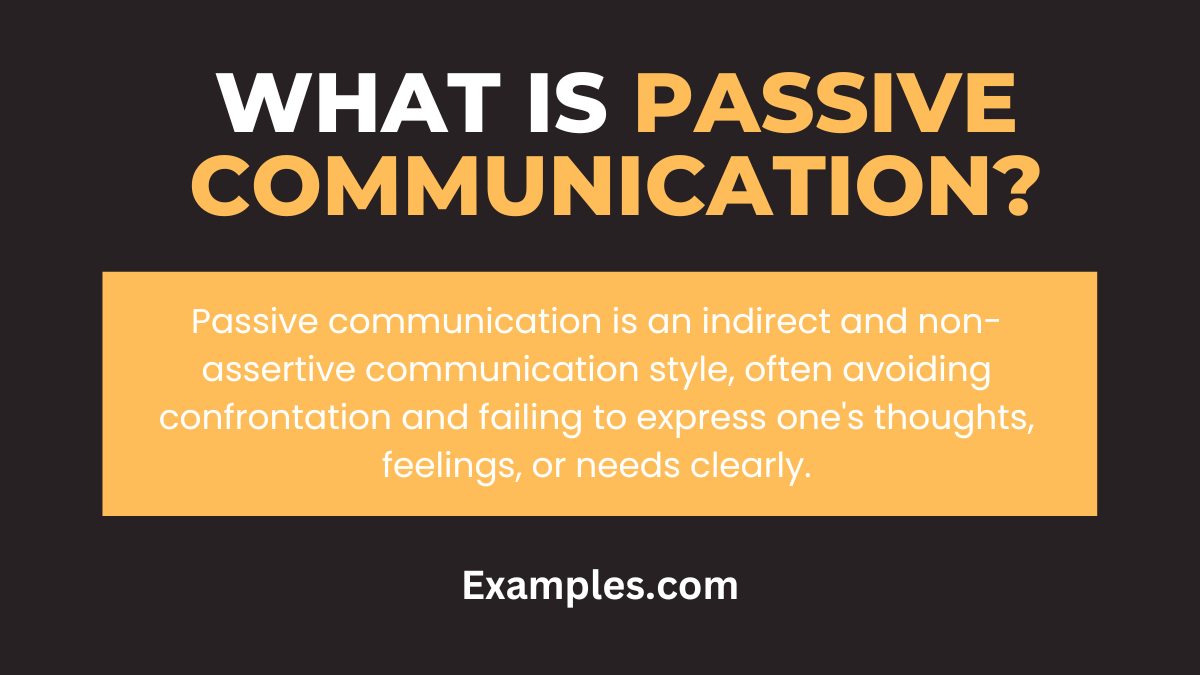What is Passive Communication?
Passive Communication is a subtle yet powerful form of interaction. Unlike assertive communication, it involves expressing one’s needs, desires, and opinions in a non-confrontational manner. This guide illuminates the essence of Passive Communication, offering detailed insights into its definition, meaning, and practical applications. Learn how to use this communication style effectively with essential tips and examples, enhancing your interpersonal skills and understanding. ‘Passive Communication’ is not just about staying quiet; it’s about conveying your message in a gentle yet impactful way.
What is Passive Communication? – Definition

Passive Communication is a style where individuals tend to avoid expressing their opinions or feelings, assert their rights, or identify their needs. In simple terms, it’s when someone chooses not to say what they really think or want. Instead of directly stating their desires or concerns, they might remain silent, yield to others, or speak very softly. This communication style often reflects a desire to avoid conflict or a lack of confidence in one’s own views. While it can seem non-confrontational, passive communication can lead to misunderstandings and unmet needs in both personal and professional relationships.
Passive Communication Examples
The Examples of Passive Communication are included below:
- Avoiding Direct Eye Contact: Someone using passive communication often avoids making direct eye contact during conversations, indicating reluctance in expressing themselves fully.
- Indirect Language: Utilizing phrases like “I guess,” “Maybe,” or “It’s just my opinion, but…” to express views, demonstrating a lack of confidence in one’s own opinions.
- Over-Apologizing: Frequently saying sorry, even in situations where they are not at fault, showing a tendency to take undue responsibility for others’ feelings or actions.
- Non-Assertive Body Language: Displaying closed-off or small body language, like slouching or crossing arms, which reflects a hesitance to assert oneself.
- Yielding to Others Easily: Quickly conceding to others’ preferences or decisions without voicing their own needs or wants.
- Hesitant Speech Patterns: Using lots of fillers like “um,” “like,” or “you know,” indicating uncertainty and a lack of confidence in their communication.
- Responding Indifferently: Often using non-committal responses like “I don’t mind” or “Whatever you think is best,” showing a reluctance to express personal preferences.
- Avoiding Confrontation: Steering clear of any form of disagreement or confrontation, even if it means not addressing issues that may be important.
- Seldom Initiating Conversations: Rarely being the one to start a conversation or bring up new topics, indicating a preference to follow rather than lead in communication.
- Giving In to Peer Pressure: Easily swayed by the opinions or desires of others, indicating a lack of personal assertiveness.
Passive Communication in the Workplace
Often characterized by a reluctance to share opinions, passive communicators in the workplace might avoid conflicts and rarely initiate discussions, leading to misunderstandings or overlooked contributions.
Characteristics of Passive Communication
Characteristics of Passive Communication involves indirect language, avoiding confrontation, non-assertive body language, and a tendency to conform to others’ opinions, often leading to a lack of personal expression.
How to Improve Passive Communication
Improvement of Passive Communication involves practicing assertiveness, expressing opinions confidently, engaging in active listening, and gradually stepping out of one’s comfort zone to initiate conversations and express needs.
Passive Communication Styles
Passive Communication styles can range from non-confrontational and agreeable to withdrawn and unresponsive, often involving indirect communication and avoidance of direct interaction or self-expression.
Types of Passive Communication
Types of Passive Communication Includes indirect speech, nonverbal cues like avoiding eye contact, underplaying one’s own needs, and consistently deferring to others, reflecting a broader spectrum of passive interaction techniques.
Benefits of Passive Communication
Benefits of Passive Communication While often seen as a drawback, passive communication can help maintain harmony, avoid conflicts, and can be effective in situations where diplomacy is required.
Passive Communication in Real Life
Passive Communication in Real Life is daily interactions, passive communication manifests as reluctance to share true feelings, hesitance in decision-making, and often yielding to others’ preferences to maintain peace.
Passive Communication in Relationships
Passive Communication in Relationships can lead to unexpressed needs and feelings, creating potential misunderstandings and frustrations, as one partner might consistently avoid conflict or asserting personal desires.
Passive Communication in Nursing
Passive Communication in nursing, it may result in hesitance to voice concerns or opinions, potentially impacting patient care. Encouraging open communication is key for optimal teamwork and patient outcomes.
Passive Communication, with its blend of advantages and disadvantages like maintaining harmony and unvoiced needs, plays a complex role in interactions. Understanding this communication style is crucial for effective relationships and professional interactions. Embrace these insights and tips for Passive Communication to navigate the nuances of passive communication, ensuring your voice is heard while maintaining a harmonious environment.



